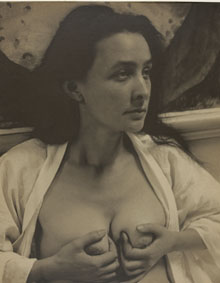
"Femme nue se coiffant" (1879) by Edouard Manet. © Christie's Images Ltd.
PARIS, FRANCE.- A work by Edouard Manet titled Femme nue se coiffant was sold at Christie’s in Paris for $7,569,408. This is a record for a painting in France since 1993. This is also a record for a nude painting by a French impressionist painter. The work was purchased by an American collector.
The years 1878 and 1879 are oftentimes heralded as Manet's great return to the nude following his notorious compositions Déjeuner sur l'herbe and Olympia of 1863. However the fact is that the artist treated the female nude only very rarely throughout his career; including the present work, only nine completed oil paintings exist in Manet's oeuvre (Wildenstein nos. 7, 40, 67, 69, 176, 226, 241, 287, 318). Along with four pastels executed the same year, Femme nue se coiffant is the last time the artist would treat the female nude in any important manner his work.
While Manet was renowned as an accomplished boulevardier - a "dandy in a top hat" - his production from 1879 includes only a smattering of scenes from modern life, amongst them a few images from a café-concert and figure groupings in parks. The vast majority of his work from this year are dedicated to portraiture, for 1879 marks the serious onset of a debilitating illness that would eventually claim his life. The professional result was numerous sittings of friends and family and painting and working sessions with his sole student, Eva Gonzalès.
While the younger members of the Parisian avant-garde held Manet in great esteem, he was continually reproached by critics and officials at the Salon for the "sketchy" handling of his compositions and for the implausible realism which, by concentrating on the act of painting itself, ushered "modern art" into existence. His focus on light, colour, form and composition foreshadow twentieth century artistic currants to come. "It was he," said Renoir speaking of his own early training, "who best rendered, in his canvases, the simple formula we were all trying to learn." Matisse echoed this thought years later, "He was the first to act by reflex, thus simplifying the painter's metier... Manet was a direct as could be... a great painter is one who finds lasting personal signs for the expression of his vision. Manet found his" (Manet, 1832-1883, exh. cat., Galeries Nationales du Grand Palais, Paris, 1983, p. 18).
Manet's working process is readily apparent in the present work. The background was first established with ochre and blue tones which he then scraped away, leaving behind only a semi-transparent wash. His frenetic pace is palpable in the ensuing execution - the model was quickly sketched and the drapery built up around her forms, resulting in a bravura performance not only technically in the creation of space and depth, but in spontaneity of subject as well. In Femme nue se coiffant, Manet achieves a fluidity and grace, a total liberation from his subject all the while capturing the vivacity in a way that not even Monet would achieve his own Nymphéas for another thirty years to come.
The "male gaze" present in Manet's work is of a very different nature to that of his contemporary - and rival - Degas. Manet himself proclaimed : "I can do nothing without nature [before my eyes]... I do not know how to invent... If I am worth something today, it is due to exact interpretation and faithful analysis" (E. Zola, "My Portrait by Edouard Manet", L'Evénement illustré, 10 May 1868; in: Gronberg, Manet: A Retrospective, New York, 1990, p. 100). Manet worked with his subject in view, yet his paintings are more like impressions of the image beheld. Degas worked in his studio from memory and sketches, yet his nudes are more like realistic transcriptions of a moment viewed from a keyhole.
So while the model for his nudes of 1879 (including the four pastels heretofore mentioned) remains somewhat of a mystery, Méry Laurent, one of the painter's closest female friends in his later years, is a plausible conjecture. A highly celebrated courtisane, Méry is said to have served as the primary model for Proust's Odette Swann. At the turn of the century, Méry was one of the great demi-mondaines and she lived a life of luxury and leisure, surrounding herself with as many fine toiletries as learned men of the arts. Prior to meeting Thomas Evans, who would become her protector, she had a short-lived career as a stage entertainer. To her Mallarmé dedicated odes, and Joris Karl Huysmans, John Lewis Brown and James McNeil Whistler were counted among her close friends. Manet was delighted by her presence, her gaity, her frivolity, and she would bring him with her to the dress-maker, Worth, and to her hat-maker on rue de la Paix. It is difficult to imagine any one else in the artist's circle of intimates who would have posed for such daring compositions.
Since its inception, Femme nue se coiffant has been in the collection of the painter's family and his descendants. Acquired at the Manet Atelier sale by his brother, Eugène, and his wife, Berthe Morisot. The work was then passed on to Julie Manet, Eugène and Berthe's only daughter, and her husband, Ernest Rouart, and with whose descendants this painting has been with ever since.
(
source)



















